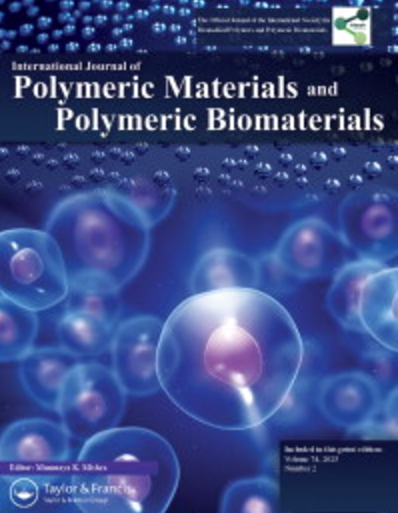DHNTs assimilated TPU/PEG membrane a new combination for evaluation of in-vitro blood-coagulation
IF 2.6
4区 医学
Q4 MATERIALS SCIENCE, BIOMATERIALS
International Journal of Polymeric Materials and Polymeric Biomaterials
Pub Date : 2023-08-13
DOI:10.1080/00914037.2022.2066670
引用次数: 1
Abstract
Abstract Thermoplastic polyurethane is known for its elasticity and hydrophobicity, which is significant for a few biomedical applications. The risk of clotting formation in blood-contacting devices is a major concern. Altering the surface of polymer with the addition of suitable nanofillers and additives can improve the blood compatibility of the prepared materials. Thus, aiming for enhanced blood compatibility of TPU (1) addition of PEG as an effective pore creator leads to enhancement in hydrophilicity, (2) modification of halloysite by universal bio-adhesives such as polydopamine, attach to the wall of HNTs by oxidation and self-polymerization, resulting as superior biomedical nanocomposites. The membrane is fabricated via the phase-inversion technique. TPU, TPU/PEG, and DHNTs@TPU/PEG were compared based on major characteristics such as hydrophilicity, pore analysis by SEM (ImageJ), and the blood compatibility test. In-Vitro blood coagulation and degradation study of pure TPU, TPU/PEG and DHNTs@TPU/PEG membrane suggest that the modified DHNTs-TPU/PEG membrane has better blood coagulation time and decreased hemolysis ratio. A degradation study with a variation in pH shows the breakage of a polymeric chain of the membrane. These results can suggest that the modified membrane has a potential application in the biomedical. Graphical AbstractDHNTs同化TPU/PEG膜是体外凝血评价的新组合
摘要热塑性聚氨酯以其弹性和疏水性而闻名,在一些生物医学应用中具有重要意义。血液接触装置中凝块形成的风险是一个主要问题。通过添加合适的纳米填料和添加剂来改变聚合物的表面,可以改善所制备材料的血液相容性。因此,为了增强TPU的血液相容性,(1)添加PEG作为有效的孔隙创造剂可以增强其亲水性;(2)用聚多巴胺等通用生物粘合剂修饰高岭土,通过氧化和自聚合将其附着在HNTs的壁上,从而形成优越的生物医学纳米复合材料。该膜是通过相变技术制备的。通过对TPU、TPU/PEG和DHNTs@TPU/PEG的亲水性、SEM (ImageJ)孔分析和血液相容性测试等主要特性进行比较。纯TPU、TPU/PEG和DHNTs@TPU/PEG膜的体外凝血降解研究表明,改性DHNTs-TPU/PEG膜具有更好的凝血时间和降低的溶血率。随着pH值的变化,降解研究表明膜的聚合链断裂。这些结果表明,改性膜在生物医学领域具有潜在的应用前景。图形抽象
本文章由计算机程序翻译,如有差异,请以英文原文为准。
求助全文
约1分钟内获得全文
求助全文
来源期刊

International Journal of Polymeric Materials and Polymeric Biomaterials
Chemical Engineering-General Chemical Engineering
CiteScore
8.00
自引率
3.10%
发文量
97
审稿时长
3.3 months
期刊介绍:
International Journal of Polymeric Materials and Polymeric Biomaterials is the official publication of the International Society for Biomedical Polymers and Polymeric Biomaterials (ISBPPB). This journal provides a forum for the publication of peer-reviewed, English language articles and select reviews on all aspects of polymeric materials and biomedical polymers. Being interdisciplinary in nature, this journal publishes extensive contributions in the areas of encapsulation and controlled release technologies to address innovation needs as well.
 求助内容:
求助内容: 应助结果提醒方式:
应助结果提醒方式:


